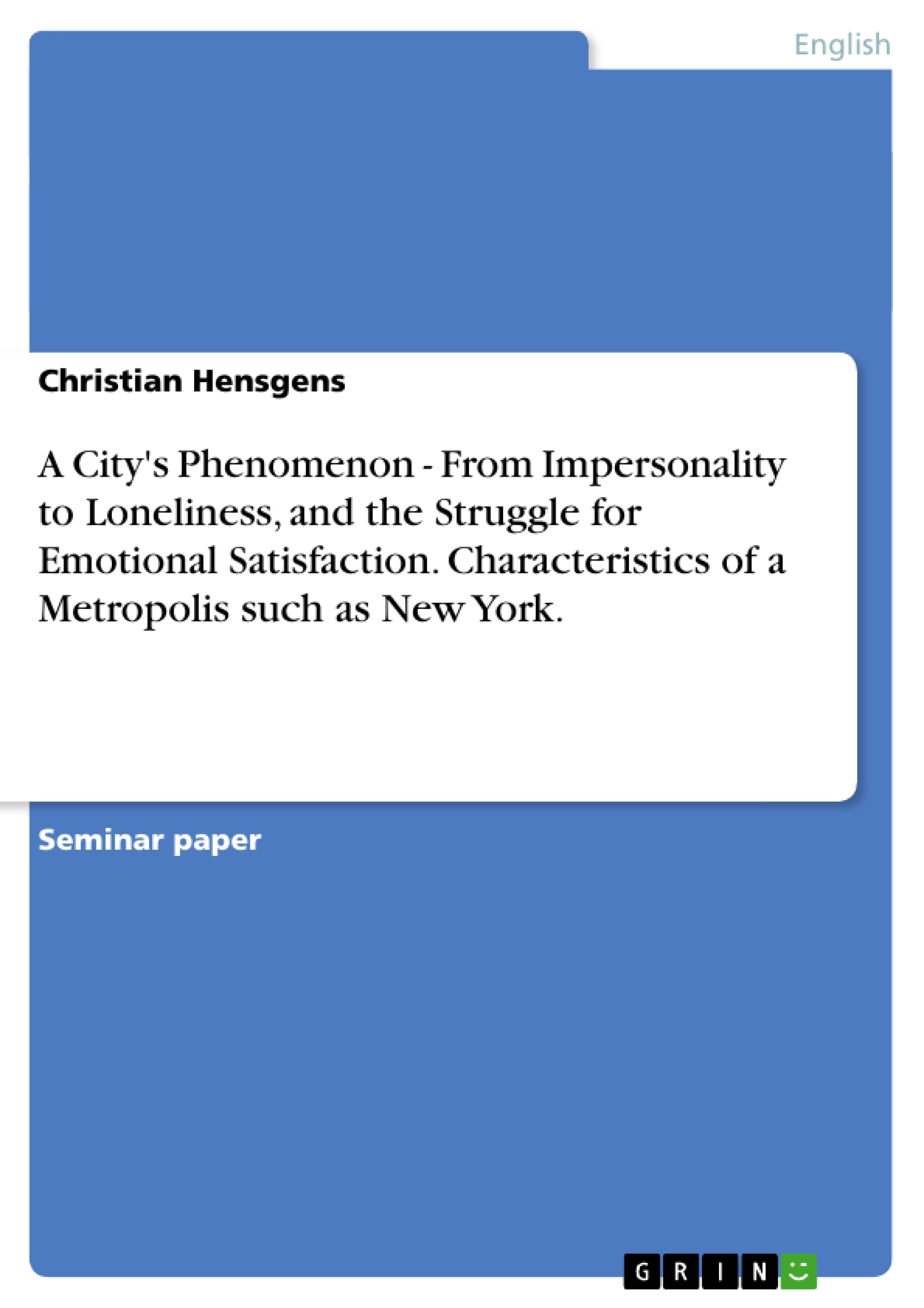New York City probably is one of the most famous cities of the world, especially known – among other things – for its diversity, size, and way of life. With a population of 8,09 million people and an annual increase of 108,500 people1 as an average value, New York is a prime example for a modern metropolis of the 21st century.
Such a metropolis typically displays numerous characteristics which are not – or just partly – applicable to a small town or to country life. No matter where many people live together, a typical life in a metropolis develops which considerably affects (especially elderly) people and influences their psychological or mental development.
In literature and arts, keywords such as 'loneliness', 'solitude', or 'isolation' frequently turn up as side effects of living in a metropolis (such is the case with Edward Hopper, for example) and several studies took a close look at the question whether or not living in a metropolis makes people mentally sick.
This academic assignment will try to design a characteristic picture of a city-dweller and the typical problems of living in a metropolis. Hereby, I will focus on the city of New York on the one hand, and on the psychological aspects in humans living in a metropolis, on the other hand.
Under these aspects, I will furthermore try to analyze Edward Hopper's 'Nighthawks' (1942), and complete this academic assignment with a look at fringe groups and their status in a modern metropolis.
Inhaltsverzeichnis (Table of Contents)
- Introduction
- A Profile of New Yorkers
- Introducing Eight Million People
- Social Psychology and Characterization of City-Dwellers
- Unique Urban Characteristics
- Impersonality, Anonymity, and Isolation and their effects on the urban community
- Mental Health in the Metropolis
- Interim Result
- who are the 'winners'? New York between self-doubt and self-fulfillment
- Edward Hopper: Biographical Notes
- "Nighthawks" and its Interpretation
- The Metropolis as Living Space for Fringe Groups
- The Elderly
- Conclusion
Zielsetzung und Themenschwerpunkte (Objectives and Key Themes)
This academic assignment aims to create a characteristic portrait of a city dweller and the typical problems associated with living in a metropolis, focusing on New York City and its psychological impact on its residents. The paper explores the unique characteristics of urban life, including impersonality, anonymity, and isolation, and analyzes their influence on the mental health of city dwellers. Furthermore, the assignment examines Edward Hopper's "Nighthawks" (1942) as a representation of metropolitan life and explores the experiences of fringe groups within a modern metropolis.
- The psychological effects of living in a metropolis
- The characteristics of city dwellers
- The role of art in depicting urban life
- The experiences of fringe groups in a metropolis
- The impact of urban life on mental health
Zusammenfassung der Kapitel (Chapter Summaries)
The introduction establishes New York City as a prime example of a modern metropolis, highlighting its size, diversity, and unique way of life. It discusses the impact of metropolitan living on people, particularly the elderly, and introduces the concept of "loneliness," "solitude," and "isolation" as side effects of urban life.
Chapter II delves into the social psychology and characterization of city dwellers, exploring the reasons for migration from rural areas to cities. It presents the concept of "quantity" and "narrowness" as essential elements of a "mental living together" in a big city. The chapter also discusses the concept of "haste" as a defining characteristic of urban life and its psychological impact on city dwellers.
Chapter III explores the question of "winners" in New York City, examining the city's potential for both self-doubt and self-fulfillment. This chapter includes an analysis of Edward Hopper's "Nighthawks," exploring its depiction of the metropolis as a living space for fringe groups and the experiences of the elderly within the urban environment.
Schlüsselwörter (Keywords)
The main keywords and focus topics of this assignment are: metropolis, urban life, city dwellers, social psychology, anonymity, isolation, mental health, Edward Hopper, "Nighthawks," fringe groups, and the elderly. These terms represent the core concepts explored in the paper, encompassing themes of urban living, psychological effects, artistic representations, and the experiences of specific groups within a metropolitan context.
- Citar trabajo
- Christian Hensgens (Autor), 2005, A City's Phenomenon - From Impersonality to Loneliness, and the Struggle for Emotional Satisfaction. Characteristics of a Metropolis such as New York., Múnich, GRIN Verlag, https://www.grin.com/document/39517



